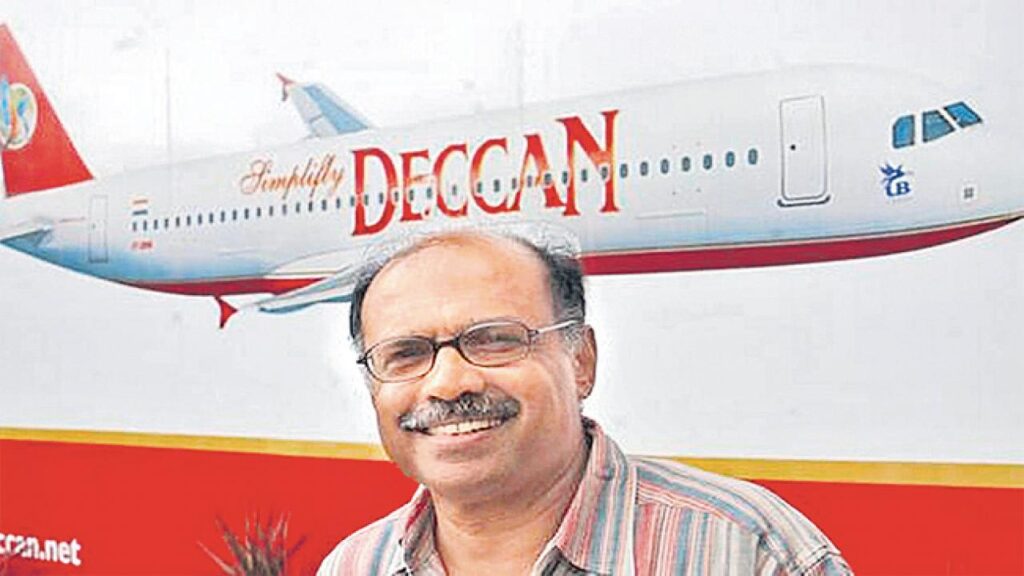Ever wonder why did Deccan Airways fail? We dig deep and provide a comprehensive analysis of the rise and fall of Air Deccan.
In the world of aviation, the stories of success are often accompanied by tales of failure. One such cautionary tale is that of Deccan Airlines, which once held the promise of revolutionizing the Indian aviation industry. In its heyday, Deccan Airways was a symbol of aspiration and progress, a pioneer that aimed to bring affordable air travel to the masses. However, this low-cost carrier’s rapid ascent was followed by an equally swift and tragic fall, leaving the industry and its patrons puzzled about the factors that led to its eventual collapse.
Deccan Airlines’ journey (slightly different from Kingfisher’s journey) began with an ambitious vision to connect the far-flung corners of India through the skies. Under the leadership of its charismatic founder, Captain G.R. Gopinath, the airline was launched in 2003, armed with a fleet of small aircraft and a strong determination to disrupt the market. Deccan Airlways’ rise was meteoric, capturing the imagination of millions of Indians who had previously never considered flying as an affordable mode of transport.
Explore our podcast
However, Deccan Airlines’ story is a testament to the fact that a rapid rise often paves the way for an equally dramatic fall. The airline faced numerous challenges, from cutthroat competition to operational inefficiencies, which ultimately led to its demise. The story of Deccan Airways is one that is worth examining, not only as a case study in the history of Indian aviation but also as a lesson for future entrepreneurs and business leaders.
In this in-depth analysis, we will explore the 18 key reasons that contributed to the failure of Deccan Airways. By delving into the details of the company’s operations and decision-making, we aim to provide valuable insights for those in the aviation industry, as well as lessons that can be applied to businesses in any sector. Following this examination, we will conclude with a reflection on the broader implications of Deccan Airways’ collapse and the lessons that can be learned from this cautionary tale.
18 Key Reasons for Deccan Airways’ Failure:
1. Aggressive Expansion without Operational Maturity
Deccan Airlines’ foundational promise — to make flying affordable for the average Indian — was potent. However, the company’s expansion blueprint was reckless. It sought to scale its fleet and route network at breakneck speed, launching dozens of new routes and aircraft with minimal operational buffers.
Instead of optimizing its core operations, Deccan chose hypergrowth. This led to a cascade of issues — aircraft scheduling mismatches, overbooked maintenance facilities, stretched ground staff, and insufficient pilot availability. The result? A chronic inability to deliver consistent, reliable service.
In hindsight, the company scaled demand on paper faster than it could scale competence on the ground.
2. Insufficient Market Research and Overestimated Demand
Deccan’s foray into Tier-2 and Tier-3 cities was rooted in optimism rather than data. The assumption: low prices would unlock vast latent demand. The reality: poor infrastructure, limited disposable income, and weak business traffic in these regions led to low load factors.
Aircraft often flew half-empty on many of these routes, making them economically unsustainable. Deccan underestimated the importance of matching frequency, timing, and pricing with regional demand dynamics.
The flaw wasn’t in the idea of expansion — but in assuming that demand would rise simply because supply existed.
3. Cost Structure Misalignment with Low-Cost Positioning
Deccan labeled itself a low-cost carrier (LCC), but its internal economics often told a different story. It failed to truly internalize the efficiency discipline that defines global LCC successes like Southwest or Ryanair.
Fuel costs remained high due to poor route and load optimization. Aircraft turnaround times were long. Revenue per seat-kilometer was low, but cost per seat-kilometer remained stubbornly high.
The result? A cost base that contradicted its pricing strategy — bleeding cash at every takeoff.
4. Poor Customer Experience and Brand Deterioration
While affordability was Deccan’s unique selling point, passengers still expected basic reliability. Unfortunately, Deccan struggled with flight delays, cancellations, last-minute schedule changes, and baggage mishandling.
Customer service teams were ill-equipped to handle complaints, often exacerbating passenger frustration. What began as an airline for the masses soon became a symbol of unreliability — eroding repeat usage and brand equity.
As the trust deficit grew, even price-sensitive consumers began migrating to competitors.
5. Failure to Monetize Ancillary Revenue Streams
In global LCC models, ticket prices are only part of the revenue equation. Smart operators earn substantial margins through baggage fees, seat selection, priority boarding, inflight meals, and brand partnerships.
Deccan failed to execute on this front. Its ancillary revenue per passenger remained negligible, leaving money on the table. This was a crucial miss — especially in a market where profit margins on ticket sales were razor thin.
The company didn’t just need more passengers — it needed better unit economics per passenger.
6. Mismanagement of Day-to-Day Operations
Operational excellence is the backbone of any aviation enterprise — especially one flying on tight margins. Deccan faltered in core areas: crew scheduling, aircraft maintenance coordination, and ground staff training.
The consequences were cumulative: excessive aircraft downtime, avoidable cancellations, and regulatory scrutiny. Inefficiencies spiraled into cost overruns and frequent operational bottlenecks.
7. High Employee Turnover and Cultural Fragility
A motivated, experienced crew can make or break an airline. Deccan, however, suffered from chronic attrition — especially among its cabin crew and mid-level managers.
This led to a vicious cycle: poor service quality drove customer dissatisfaction, which led to more complaints and internal stress, causing burnout and further attrition.
The company lacked a strong internal culture or incentive system to retain top talent — undermining its human capital foundation during critical phases of growth.
8. Weak Marketing and Brand Positioning
Deccan’s marketing narrative began as disruptive — “Simplifly” — but never evolved. As competitors improved their branding, Deccan remained stuck in its original messaging, failing to emotionally connect with aspirational or value-conscious flyers.
The brand struggled to reposition itself as reliable, aspirational, or even fun. Its utilitarian tone failed to build enduring customer loyalty in a rapidly evolving consumer landscape.
9. Intense Competitive Pressure
By the mid-2000s, India’s aviation landscape was heating up. Jet Airways, Indigo, SpiceJet, and Kingfisher were all competing for market share, each with unique models and deep investor pockets.
Deccan failed to carve out a defensible niche. It wasn’t the cheapest. It wasn’t the most reliable. It wasn’t the most premium. It was stuck in the middle — a dangerous place in any market, especially aviation.
10. Regulatory Hurdles and Infrastructure Bottlenecks
India’s regulatory environment in the early 2000s was notoriously sluggish. Route approvals took months. Airport slot availability was constrained. Smaller cities lacked adequate ground handling infrastructure.
Deccan’s lean model depended on fast turnarounds and efficient airport logistics — neither of which were consistently available. As a result, the airline bore the brunt of systemic inefficiencies while trying to play a volume game.
11. An Unsustainable Business Model
Deccan’s model was disruptive but ultimately unsustainable.
Their cost base was too high, margins too thin, and capital reserves too low to absorb the volatility of the aviation industry. The business was built for rapid expansion — not durable profitability.
In the absence of a clear path to scale sustainably, even the best-intentioned business model became structurally flawed.
12. Complex and Costly Fleet Composition
A major operational flaw was Deccan’s fleet diversity. Instead of standardizing aircraft models (a key LCC principle), Deccan operated a mix — ATRs for short-haul regional routes, Airbus A320s for longer ones.
This led to:
- Different maintenance protocols
- Diverse crew training requirements
- Increased inventory and spare part costs
- Reduced fleet flexibility
A standardized fleet could have lowered costs and improved turnaround times — but Deccan missed that opportunity.
13. Volatile Fuel Prices and Weak Hedging Strategies
Fuel is an airline’s single largest variable expense. Deccan was highly vulnerable to fluctuations in crude oil prices and lacked robust fuel hedging strategies that might have insulated it from global price shocks.
In a high fuel price environment, every delay, long route, or half-empty aircraft compounds the burn — and Deccan found itself at the mercy of macroeconomic headwinds it couldn’t control.
14. Inefficient Route Planning
Route optimization is both art and science. Deccan struggled with both.
Their expansion into low-demand cities combined with suboptimal flight timings led to low occupancy rates. There was minimal coordination between flight schedules, connecting routes, and customer preferences.
Aircraft were underutilized, and crew costs per flight hour rose as a result.
15. A Brand Suffering from Negative Perceptions
The frequent cancellations, delays, and customer service issues translated into a brand image problem. In public perception, Deccan became synonymous with “cheap” — not “value.”
And in aviation, where safety and reliability are paramount, a damaged brand often creates a trust gap that’s hard to recover from — no matter how good the intentions or pricing may be.
16. Leadership Misalignment and Over-Optimism
G. R. Gopinath’s vision was bold and idealistic, but leadership execution wavered. The management team emphasized speed and scale over sustainable profitability and process discipline.
The dream of connecting “Bharat” was commendable — but it was prematurely executed. The market, infrastructure, and financial maturity simply weren’t ready to support that ambition at the speed Deccan demanded.
17. Financial Fragility and Poor Capital Management
Deccan constantly operated under financial strain. It lacked deep pockets, consistent profitability, or a strategic financial partner willing to absorb short-term losses for long-term returns.
High interest loans, poor cash flow cycles, and mounting liabilities eventually crippled its ability to invest in improvements, retain staff, or even maintain fleet reliability.
18. The Ill-Fated Kingfisher Merger
In 2007, Deccan merged with Kingfisher Airlines — a move intended to create scale and complementary synergies. But the merger only amplified the weaknesses of both airlines.
The brands were culturally misaligned. Operational synergies didn’t materialize. Debt spiraled. Kingfisher’s premium brand conflicted with Deccan’s value positioning. Eventually, both names disappeared from Indian skies — a cautionary tale of misplaced hope.
The story of Deccan Airlines serves as a cautionary tale for businesses in any industry. While the company’s ambitious vision and rapid growth initially captured the attention of millions, its operational challenges, management missteps, and competitive pressures ultimately led to its collapse. This case study highlights the importance of maintaining a strong focus on the fundamentals of business, such as cost control, customer satisfaction, and efficient operations.
Moreover, Deccan Airlines’ failure underscores the need for businesses to adapt and evolve in the face of a rapidly changing market. The company’s inability to pivot its business model and address the various challenges it faced ultimately sealed its fate. Entrepreneurs and business leaders should use this example as a reminder to continuously reassess their strategies and adapt to the changing needs of their customers and the market.
In conclusion, the rise and fall of Deccan Airlines offer valuable lessons for businesses across industries. By examining the various factors that contributed to the airline’s failure, we can glean insights into the complexities of running a successful enterprise and the importance of agility and adaptability in today’s business landscape. As we continue to navigate the ever-evolving world of commerce, the story of Deccan Airlines serves as a powerful reminder of the need for prudent decision-making, effective management, and a relentless focus on the customer.
If you’re a startup founder, submit your startup story for free with us
Did you know? Startups like to use our plug and play work space in Bangalore
Learn more about us on our YouTube channel Work Theater Studios where we talk about a variety of topics including personal finance, entrepreneurship, business and life.
Fun fact! We also have a private theatre in Bangalore





1 thought on “Why Did Deccan Airways Fail? The Rise and Fall of Deccan Airways”
For the reason that the admin of tthis web site is working, no hesitation very quickly it
will bee well-known, due to its quality contents.